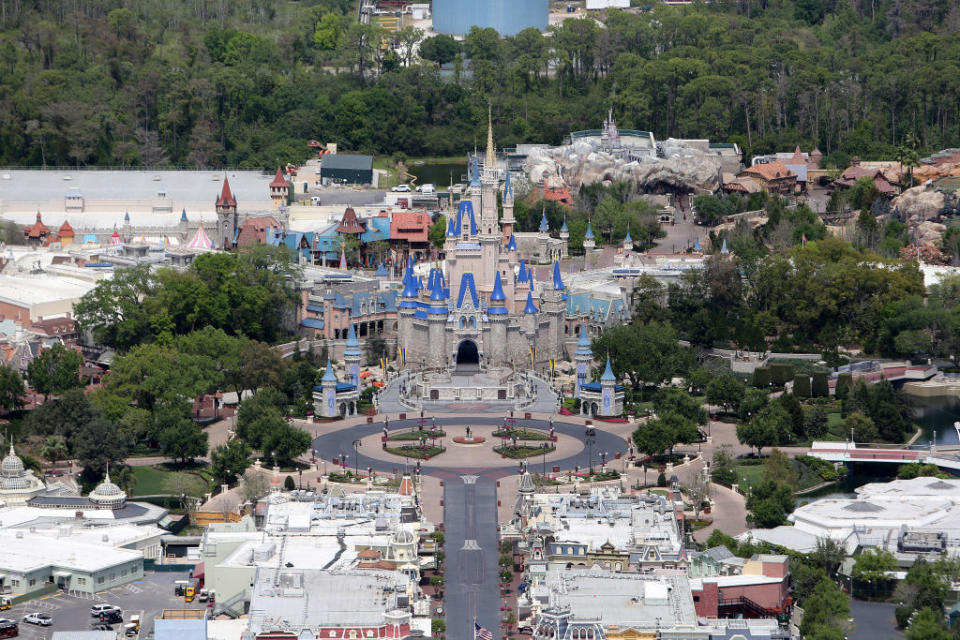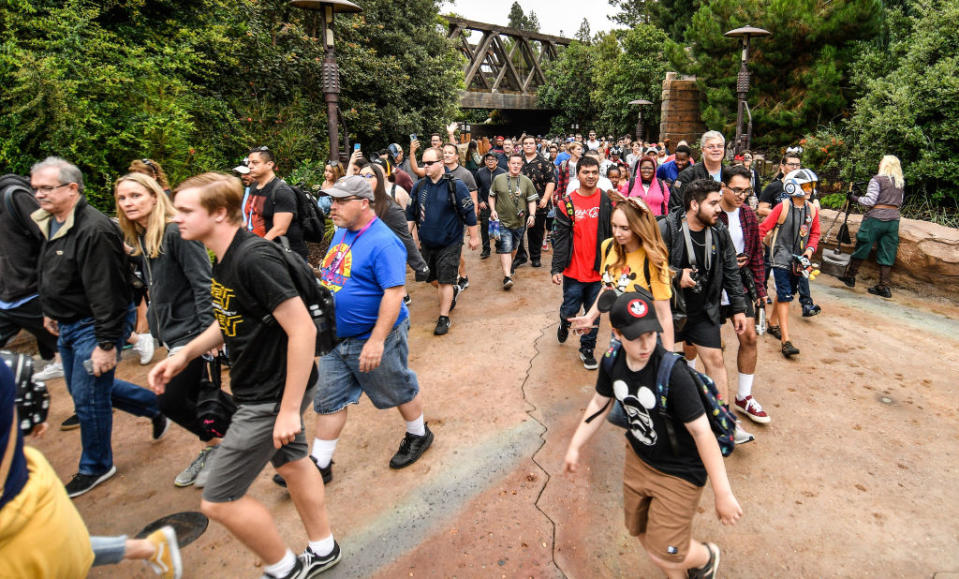The future of Disney World: Here's what visiting Disney, Universal and other amusement parks will look like after coronavirus
It’s the year 2029, and you’ve arrived for a day at Walt Disney World. You’ve made your reservations ahead of time, as you always do now, and once you arrive, the park is a lot less crowded than you ever remember it being before the coronavirus pandemic of 2020.
People in line for Star Wars: Rise of the Resistance are staggered much further apart than they would have been at that time. It’s almost like thinking back to when people just called up their friends to talk rather than texting or emailing. After you take a turn on Pirates of the Caribbean — in a boat carefully distanced away from other parties — you make sure your face mask is secure and head over to the eatery you’ve reserved seats for at lunch.

How weird is it to remember that there was once a time when people (without masks) would just show up at the park?
No one knows exactly what’s going to happen to theme parks, which shut down worldwide in response to the coronavirus in March, following the health crisis. What does seem clear is that, at least for a time, a day there will be a lot different than what we’ve come to expect, although that’s not necessarily a bad thing.
“I was thinking about the 1918 flu, which wiped out millions and how life eventually got back to normal after that, and so I’m hopeful that someday we will be able to go back to theme parks the way we used to,” said Martin Lewison, an associate professor of business management at Farmingdale State College in New York who teaches a class on amusement parks and tourism. “Maybe people will be a little more careful about washing their hands and things like that, but it's certainly within the realm of possibility.”
We’re not there yet. There continues to be a lack of understanding about many factors of the virus, even as many states begin to reopen. It’s tough to see what will happen when it comes to theme parks… or any businesses, for that matter. But we have some clues, mostly from Disney, which tends to lead the way in the industry.
Bob Iger, the executive chairman of Walt Disney Co., said in April that the company was considering checking the temperature of guests when they entered the park, just as they check bags for weapons.
Then, on Tuesday, Disney’s chief medical officer, Dr. Pamela Hymel, outlined several other safety measures the company is considering, which includes limiting the number of people allowed into the park or any specific part of it — even lines.
Today, we’re sharing an update from Chief Medical Officer Dr. Pamela Hymel about our plans and considerations as we prepare for the reopening of our Disney parks, resorts and stores: https://t.co/90NnSvOR2o pic.twitter.com/5wQonjx8um
— Disney Parks (@DisneyParks) May 5, 2020
“As you can imagine, managing guest density in queues, restaurants, hotels, ride vehicles and other facilities throughout the park and across the resort is a major focus, as we implement physical distancing guidelines based on guidance from health authorities,” Hymel said. Here are the new safety measures:
Limited and pulsed attendance with an advanced reservation and entry system: Guests are required to purchase admission tickets valid on a selected date only and Annual Pass holders must make a reservation prior to arrival.
Controlled guest density: Capacity will be recommended and managed in queues, restaurants, ride vehicles and other facilities. Queues will be structured and ride vehicles will be loaded to promote social distancing.
Implementing required government health and prevention procedures: This includes temperature screening and the use of the government-issued Shanghai Health QR code, a contact tracing and early detection system used in China. Additionally, guests must wear a mask during their visit, except when dining.
Increased sanitization and disinfection measures: Hand sanitizers will be available at queue entries and attraction exits. High-touch locations, such as ride vehicles, handlebars, queue railings and turnstiles will have increased sanitization.
Training for cast members: Cast members will receive training on procedures with an emphasis on contactless guest interaction, cleaning and social distancing and will receive additional protective equipment including masks.
With Disney considered the industry leader, other parks will likely follow with similar guidelines.
Universal Studios in Florida surveyed its fans in April about their opinions on potential safeguards, including rapid testing for COVID-19 for guests and employees.
Six Flags websites already state that, once it reopens, impromptu visits will be a thing of the past, at least in the beginning: “To meet state social distancing guidelines and ensure the health and safety of our guests, all visits to the park must be pre-scheduled using our online reservation system.”
Lewison, a roller-coaster enthusiast who visits roughly 100 theme parks a year, said a system like that might not be what we’re used to, but it makes sense.
“This way, by having reservations, they can just better plan what size crowd they’re going to have,” Lewison said. “It’s better for the guests, and it’s better for the park. The park knows how many guests are coming and if you’re a guest, you’re not going to drive two hours and then find out that they're letting 10,000 people in and you’re 10,001, so you don't get in. So I wouldn’t be shocked if Disney did something like this as well.”
Once you’re inside the park, there are other variables. Some rides might need to be redesigned so guests are farther apart. The way people are funneled onto rides, like those long, twisty lines might need to be altered. Should rides be cleaned and sanitized after each cycle? And then there’s the question of masks.
“Do you suggest to guests that they wear face masks, or do you require guests to wear a face mask, and then do you have the face mask police in the theme park?” Lewison said. “And that’s kind of a big bummer, because people want to forget their cares when they go to the theme park and not have to worry about things, but at least in the near- and medium-term, the parks and the guests are going to have to negotiate some kind of mask.”

It’s not clear if guests will be able to interact with park workers — called “cast members” at Disney — dressed as characters. We do know that they won’t at Shanghai Disneyland, which is scheduled to begin a phased reopening May 11. Disney CEO Bob Chapek said Tuesday during an earnings call that characters will be social distancing and most of them, all but human characters such as Snow White and Cinderella, will be wearing masks.
The reopening of Shanghai Disneyland will be a test exercise for Disney in many ways. The Chinese government has limited the number of guests the park can have to 30 percent of its normal operating capacity, but Disney is going to go below that number early on, Chapek said Tuesday. So while 80,000 people is peak capacity, Shanghai Disneyland will aim for fewer than 24,000.
“Just to have our training wheels on with our new procedures and processes,” Chapek said on the call, “to make sure we don’t have any lines backing up either as guests entering into the park or as they wade through the park.”
Amusement parks are at a crucial moment, as Lewison noted.
“They have this problem: How do we reopen safely? If you make mistakes, then you have to close up again,” Lewison said. “So you can just imagine staffing up, getting a workforce, getting them trained, getting everything ready and then finding out that you’re a vector for the virus and then you have to shut down again anyway. So that would be a nightmare for all involved.”
Disney’s Chapek made his announcement in the same meeting he reported that the company’s quarterly profit fell a whopping 90 percent in the last quarter, with closures accounting for a 58 percent drop in operating revenue for the company’s parks. Keep in mind that his company has Disney+ and other revenue outlets, which many other amusement and theme park companies don’t.
Lewison, who lives in Queens, N.Y., with his wife, an emergency room doctor, is rooting for the theme parks, particularly the smaller regional and family-owned parks. He’d like to be back at one of them soon.
“We were going to go to Tokyo — and Tokyo Disney — in March for spring break but then spring break got canceled,” he said. “We were in Vietnam in January. We were riding roller coasters around Vietnam, which was a great trip. And then we came back, school started and then school only lasted about six weeks.”
Social distancing is a part of our everyday lives. The below experience allows you to place art in the space between. Place the image in front of you and move it around to line up with your loved one.
Read more from Yahoo Entertainment:




